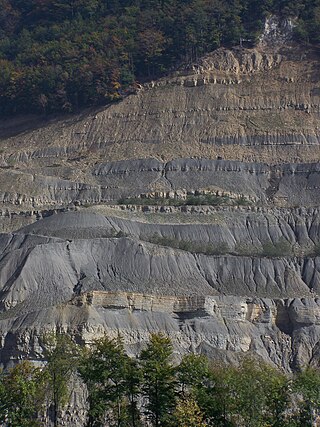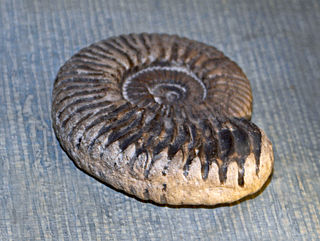
Ammonoids are extinct spiral shelled cephalopods comprising the subclass Ammonoidea. They are more closely related to living coleoids than they are to shelled nautiloids. The earliest ammonoids appeared during the Devonian, with the last species vanishing during or soon after the Cretaceous–Paleogene extinction event. They are often called ammonites, which is most frequently used for members of the order Ammonitida, the only remaining group of ammonoids from the Jurassic up until their extinction.

The Oxfordian is, in the ICS' geologic timescale, the earliest age of the Late Jurassic Epoch, or the lowest stage of the Upper Jurassic Series. It spans the time between 161.5 ± 1.0 Ma and 154.8 ± 0.8 Ma. The Oxfordian is preceded by the Callovian and is followed by the Kimmeridgian.
In the geologic timescale, the Kimmeridgian is an age in the Late Jurassic Epoch and a stage in the Upper Jurassic Series. It spans the time between 154.8 ±0.8 Ma and 149.2 ±0.7 Ma. The Kimmeridgian follows the Oxfordian and precedes the Tithonian.
Abbasites is an extinct genus of ammonites from the early Middle Jurassic epoch, included in the ammonitid family Erycitidae.

Aspidoceras is an extinct ammonoid cephalopod genus belonging to the family Aspidoceratidae.
Glochiceras is a haploceratid ammonite characterized by a small, smooth, compressed, evolute shells with large lappets and a median lateral groove. Its geographic distribution is fairly cosmopolitan, but it is limited stratigraphically to the Oxfordian and Kimmeridgian stages in the Upper Jurassic.
Unipeltoceras is an extinct ammonite genus included in the perisphictacian family, Aspidoceratidae, and a member of the subfamily Peltoceratinae, that lived during the Callovian stage, late in the Middle Jurassic.

Ammonitina comprises a diverse suborder of ammonite cephalopods that lived during the Jurassic and Cretaceous periods of the Mesozoic Era. They are excellent index fossils, and it is often possible to link the rock layer in which they are found to specific geological time periods.

Perisphinctoidea, formerly Perisphinctaceae, is a superfamily of Middle Jurassic (Bajocian) to Lower Cretaceous (Barremian) ammonites, commonly with evolute shells with strong ribbing that typically divides about mid flank before crossing the venter.
The Haploceratidae is the type family of the Haploceratoidea, a superfamily in the ammonitina; which according to Donovan et al. (1981) can be derived from the Taramelliceratinae, a subfamily of the Oppeliidae.

The Aspidoceratidae comprise a family of middle and upper Jurassic ammonites that make up part of the superfamily Perisphinctoidea, characterized by evolute shells, commonly stocky, that tend to develop tubercles.

The Peltoceratinae comprise a subfamily in the Aspidoceratidae,.

Perisphinctidae is a family of Middle and Upper Jurassic discoidal ammonites in the order Ammonitida. They have a shell morphology that is mostly evolute, typically with biplicate, simple, or triplicate ribbing. Large forms have simple apertures and smooth body chambers while small forms have lappets and ribbed body chambers.
Sutneria is a genus of small ammonites from the Upper Jurassic (Kimmeridgian) of Europe (Germany). Its shell is generally evolute with a narrowly rounded whorl section and tubercles along the lower flanks.

The family Dactylioceratidae comprises Early Jurassic ammonite genera with ribbed and commonly tuberculate shells that resembled later Middle Jurassic stephanoceratids and Upper Jurassic perisphinctids. Shells may be either evolute or involute.

Pseudowaagenia is a genus of extinct ammonoid cephalopods in the family Aspidoceratidae.

Aulacostephanidae is an extinct ammonoid cephalopod family belonging to the superfamily Perisphinctoidea. These fast-moving nektonic carnivores lived during the Upper Jurassic period, from the Oxfordian to Tithonian ages.
Oppeliinae is a subfamily within the Oppeliidae, a family of Jurassic ammonites characterized by forms that are mainly oxyconic, compressed with sharp venters, in the adult and with keeled inner whorls. Sutures are complex, consisting of a long series of evenly graded lobes and saddles with finely frilled endings.
Mazapilitinae is a subfamily of Upper Jurassic ammonites included in the Oppeliidae. Shells are involute; venter rounded or gently tabulate; ribbing coarse, fold-like, branching.
Oxydiscites is a genus of ammonites from the Upper Jurassic Kimmeridgian included in the Ochetoceratinae, Oppeliidae. The shell is involute, compressed, with a minute umbilicus, sharp venter with a tall finely toothed keel, and faloid ribbing.









